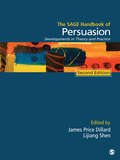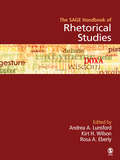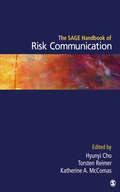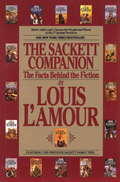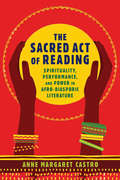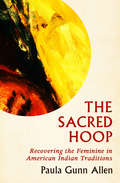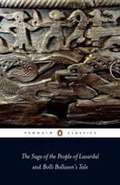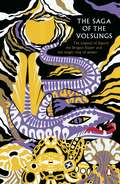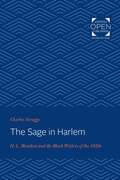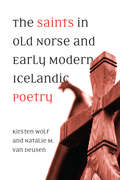- Table View
- List View
The SAGE Handbook of Persuasion: Developments in Theory and Practice
by James Price Dillard Lijiang ShenThe Second Edition of The SAGE Handbook of Persuasion: Developments in Theory and Practice provides readers with logical, comprehensive summaries of research in a wide range of areas related to persuasion. From a topical standpoint, this handbook takes an interdisciplinary approach, covering issues that will be of interest to interpersonal and mass communication researchers as well as to psychologists and public health practitioners.
The SAGE Handbook of Rhetorical Studies
by Andrea A. Lunsford Dr Kirt H. Wilson Rosa A. EberlyThe SAGE Handbook of Rhetorical Studies surveys the latest advances in rhetorical scholarship, synthesizing theories and practices across major areas of study in the field and pointing the way for future studies. Edited by Andrea A. Lunsford and Associate Editors Kirt H. Wilson and Rosa A. Eberly, the Handbook aims to introduce a new generation of students to rhetorical study and provide a deeply informed and ready resource for scholars currently working in the field.
The SAGE Handbook of Risk Communication
by Hyunyi Cho Torsten Reimer Katherine A. MccomasIn this comprehensive, state-of-the-art overview of risk communication, the field’s leading experts summarize theory, current research, and practice in a range of disciplines and describe effective communication approaches for risk situations in diverse contexts, such as health, environment, science, technology, and crisis. Offering practical insights, the contributors consider risk communication in all contexts and applications—interpersonal, organizational, and societal—offering a wider view of risk communication than other volumes. Importantly, the handbook emphasizes the communication side of risk communication, providing integrative knowledge about the models, audiences, messages, and the media and channels necessary for effective risk communication that enables informed judgments and actions regarding risk. Editors Hyunyi Cho, Torsten Reimer, and Katherine McComas have significantly contributed to the field of risk communication with this important reference work—a must-have for students, scholars, and risk and crisis communication professionals.
The SAGE Handbook of Risk Communication
by Hyunyi Cho Torsten Reimer Katherine A. McComasIn this comprehensive, state-of-the-art overview of risk communication, the field’s leading experts summarize theory, current research, and practice in a range of disciplines and describe effective communication approaches for risk situations in diverse contexts, such as health, environment, science, technology, and crisis. Offering practical insights, the contributors consider risk communication in all contexts and applications—interpersonal, organizational, and societal—offering a wider view of risk communication than other volumes. Importantly, the handbook emphasizes the communication side of risk communication, providing integrative knowledge about the models, audiences, messages, and the media and channels necessary for effective risk communication that enables informed judgments and actions regarding risk. Editors Hyunyi Cho, Torsten Reimer, and Katherine McComas have significantly contributed to the field of risk communication with this important reference work—a must-have for students, scholars, and risk and crisis communication professionals.
The SAGE Handbook of the Digital Media Economy
by Julian Thomas Terry Flew Jennifer HoltDebates about the digital media economy are at the heart of media and communication studies. An increasingly digitalised and datafied media environment has implications for every aspect of the field, from ownership and production, to distribution and consumption. The SAGE Handbook of the Digital Media Economy offers students, researchers and policy-makers a multidisciplinary overview of contemporary scholarship relating to the intersection of the digital economy and the media, cultural, and creative industries. It provides an overview of the major areas of debate, and conceptual and methodological frameworks, through chapters written by leading scholars from a range of disciplinary perspective. PART 1: Key Concepts PART 2: Methodological Approaches PART 3: Media Industries of the Digital Economy PART 4: Geographies of the Digital Economy PART 5: Law, Governance and Policy
The SAGE Handbook of the Digital Media Economy
by Julian Thomas Terry Flew Jennifer HoltDebates about the digital media economy are at the heart of media and communication studies. An increasingly digitalised and datafied media environment has implications for every aspect of the field, from ownership and production, to distribution and consumption. The SAGE Handbook of the Digital Media Economy offers students, researchers and policy-makers a multidisciplinary overview of contemporary scholarship relating to the intersection of the digital economy and the media, cultural, and creative industries. It provides an overview of the major areas of debate, and conceptual and methodological frameworks, through chapters written by leading scholars from a range of disciplinary perspective. PART 1: Key Concepts PART 2: Methodological Approaches PART 3: Media Industries of the Digital Economy PART 4: Geographies of the Digital Economy PART 5: Law, Governance and Policy
The Sackett Companion: The Facts Behind the Fiction
by Louis L'AmourLittle did Louis L'Amour realize back in 1960 when he published The Daybreakers, a novel about two brothers who came west after the Civil War, that he had begun creating what would become perhaps North America's most widely followed literary family: the Sacketts. The stories of ten generations of Sackett men and women as they forged westward from tyranny-wracked seventeenth-century England across the American continent have captivated readers for three decades through seventeen novels with nearly forty millions copies in print. The traditions and adventures of this family of rugged individualists who stand indomitably united when any Sackett is in trouble have inspired country songs, a popular television miniseries starring Tom Selleck (as Orrin Sackett) and Sam Elliot (as Tell Sackett), thousands of reader queries--and now, a rare full-length work of non-fiction by the worlds' all-time best-selling frontier novelist.In a 60 Minutes profile in which he hailed Louis L'Amour as "our professor emeritus of how the West was won," correspondent Morley Safer observed that "his plots may be fiction but the details therein are fact." The Sackett Companion is the author's long-savored opportunity to present the research and probe the factors behind his Sackett fiction--novel by novel--and to elaborate on their real and fictional characters, their geography and locales, and their historical eras in encyclopedia-like detail.In this book, subtitled A Personal Guide To The Sackett Novels, L'Amour takes us on a guided tour of his imagination to introduce us to the never-before-told sources and inspirations for these stories and the people and places that populate them. He retraces some of his travels in which he has walked the land the Sacketts walk, reliving such personal memories as the street fight he had on a hot dusty morning in New Mexico that ultimately led to the birth of the Sacketts.From the Trade Paperback edition.
The Sacred Act of Reading: Spirituality, Performance, and Power in Afro-Diasporic Literature (New World Studies)
by Anne Margaret CastroFrom Zora Neale Hurston to Derek Walcott to Toni Morrison, New World black authors have written about African-derived religious traditions and spiritual practices. The Sacred Act of Reading examines religion and sociopolitical power in modern and contemporary texts of a variety of genres from the black Americas. By engaging with spiritual traditions such as Vodou, Kumina, and Protestant Christianity while drawing on canonical Eurocentric literary theory, Anne Margaret Castro presents a novel, nuanced reading of power through the physical and metaphysical relationships portrayed in these great works of New World black literature.Castro examines prophecy in the dramas of Derek Walcott, preaching in the ethnography of Zora Neale Hurston, and liturgy in the novels of Toni Morrison, offering comparative readings alongside the works of Afro-Colombian anthropologist Manuel Zapata Olivella, Jamaican sociologist Erna Brodber, and Canadian fiction writer Nalo Hopkinson. The Sacred Act of Reading is the first book to bring together literary texts, historical and contemporary anthropological studies, theology, and critical theory to show how black authors in the Americas employ spiritual phenomena as theoretical frameworks for thinking within, against, and beyond structures of political dominance, dependence, and power.
The Sacred Complex: On the Psychogenesis of Paradise Lost
by William KerriganThis reading of Milton juxtaposes the poet's theology and Freud's account of the Oedipus complex in ways that yield both new understanding of Milton and a model for psychoanalytic interpretation of literature. The book ranges widely through the art and life of Milton, including extensive discussions of his theological irregularities and the significance, medical and symbolic, he assigned to his blindness. Kerrigan analyzes the oedipal aspect of Milton's religion; examines the nature of the Miltonic godhead; studies Milton's analogies linking human, angelic, and cosmic bodies; and explores Milton's symbolism of home. In a commanding demonstration, Kerrigan delineates how the great epic and the psyche of its author bestow meaning on each other.
The Sacred Hoop: Recovering the Feminine in American Indian Traditions
by Paula Gunn AllenAlmost thirty years after its initial publication, Paula Gunn Allen&’s celebrated study of women&’s roles in Native American culture, history, and traditions continues to influence writers and scholars in Native American studies, women&’s studies, queer studies, religion and spirituality, and beyond This groundbreaking collection of seventeen essays investigates and celebrates Native American traditions, with special focus on the position of the American Indian woman within those customs. Divided into three sections, the book discusses literature and authors, history and historians, sovereignty and revolution, and social welfare and public policy, especially as those subjects interact with the topic of Native American women. Poet, academic, biographer, critic, activist, and novelist Paula Gunn Allen was a leader and trailblazer in the field of women&’s and Native American spirituality. Her work is both universal and deeply personal, examining heritage, anger, racism, homophobia, Eurocentrism, and the enduring spirit of the American Indian.
The Sacred River: An Approach to James Joyce (Routledge Revivals)
by L.A.G. StrongFirst Published in 1949, The Sacred River attempts to present a survey of James Joyce’s work. In 1932 Mr Strong published an essay in the course of which he suggested that Work in Progress was the first full scale application to the novel of twentieth century ideas on space and time, demanding from the reader a radical change in practice. The essay was read by Joyce, and the theory subsequently confirmed. From that point Mr Strong has continued his study of Joyce. This work is limited to four main lines of approach: interest in singing and singers, a passion with Joyce; literature, in particular Shakespeare, Swift, Blake, and the Romantic Movement, of which the author believes Finnegans Wake to be the logical fulfilment; contemporary theories of psychology; and Christian metaphysics. Mr Strong’s first-hand acquaintance with Dublin in the early nineteen-hundreds has been a further help, as was his friendship with Yeats, A.E., and other Irish writers who knew Joyce personally. The result is a stimulating and provocative piece of criticism, of which we may safely say that it outruns its modest programme. This book is a must read for scholars and researchers of English literature.
The Sacred Wood: Essays on Poetry and Criticism
by Rachel TeubnerThe essay for which The Sacred Wood is primarily remembered is one of the most famous pieces of criticism in English: “Tradition and the Individual Talent” helped to re-orientate arguments about the study of literature and its production by redefining the nature of tradition and the artist's relation to it.At a time when the word “traditional” had become a way of damning with faint praise by reference to the past, Eliot reinterpreted the term to mean something entirely different. It is not, he argues, something just “handed down,” but, instead, a prize to be obtained “by great labour,” not least in the making of a huge effort of understanding how the past fits together. Seen thus, Eliot suggests, a literary and artistic tradition “has a simultaneous existence and composes a simultaneous order” – and it is not just past, but present as well. For Eliot, “art never improves,” but only changes, and each part of the tradition is constantly being reinterpreted in light of what is added to the whole. The role of the poet, in Eliot's view, is to subjugate their own personality, and become “a receptacle,” in which “numberless feelings, phrases, images… can unite to form a new compound.” Redefining the issue of poets' relations to the past in this new way is a fine example of creative thinking, and Eliot’s ability to connect existing concepts in new ways was what gave weight to the argument that he advanced: that poets cannot succeed without understanding that they are taking their place on a continuum that stretches back to all their predecessors, and incorporate the ideas, strengths and failings of the entire body of work that those poets represented.
The Sacred Wood: Essays on Poetry and Criticism
by T. S. EliotThis was the first volume of Mr. Eliot's criticism to be published, and it includes essays on Dante, Swinburne, Blake and the contemporaries of Shakespeare ; on poetry, poetic drama and the criticism of poetry. They were the product of his early writing days and are especially interesting as evidence of Mr. Eliot's ideas on literature at that time.
The Saddest Words: William Faulkner's Civil War
by Michael GorraHow do we read William Faulkner in the twenty-first century? asks Michael Gorra, in this reconsideration of Faulkner's life and legacy. William Faulkner, one of America’s most iconic writers, is an author who defies easy interpretation. Born in 1897 in Mississippi, Faulkner wrote such classic novels as Absolom, Absolom! and The Sound and The Fury, creating in Yoknapatawpha county one of the most memorable gallery of characters ever assembled in American literature. Yet, as acclaimed literary critic Michael Gorra explains, Faulkner has sustained justified criticism for his failures of racial nuance—his ventriloquism of black characters and his rendering of race relations in a largely unreconstructed South—demanding that we reevaluate the Nobel laureate’s life and legacy in the twenty-first century, as we reexamine the junctures of race and literature in works that once rested firmly in the American canon. Interweaving biography, literary criticism, and rich travelogue, The Saddest Words argues that even despite these contradictions—and perhaps because of them—William Faulkner still needs to be read, and even more, remains central to understanding the contradictions inherent in the American experience itself. Evoking Faulkner’s biography and his literary characters, Gorra illuminates what Faulkner maintained was “the South’s curse and its separate destiny,” a class and racial system built on slavery that was devastated during the Civil War and was reimagined thereafter through the South’s revanchism. Driven by currents of violence, a “Lost Cause” romanticism not only defined Faulkner’s twentieth century but now even our own age. Through Gorra’s critical lens, Faulkner’s mythic Yoknapatawpha County comes alive as his imagined land finds itself entwined in America’s history, the characters wrestling with the ghosts of a past that refuses to stay buried, stuck in an unending cycle between those two saddest words, “was” and “again.” Upending previous critical traditions, The Saddest Words returns Faulkner to his sociopolitical context, revealing the civil war within him and proving that “the real war lies not only in the physical combat, but also in the war after the war, the war over its memory and meaning.” Filled with vignettes of Civil War battles and generals, vivid scenes from Gorra’s travels through the South—including Faulkner’s Oxford, Mississippi—and commentaries on Faulkner’s fiction, The Saddest Words is a mesmerizing work of literary thought that recontextualizes Faulkner in light of the most plangent cultural issues facing America today.
The Saga of the Jómsvíkings
by Lee M. HollanderA loyal translation of the medieval Icelandic saga of a strong ruler and his men versus a brotherhood of fierce Viking mercenaries.In A.D. 986, Earl Hákon, ruler of most of Norway, won a triumphant victory over an invading fleet of Danes in the great naval battle of Hjórunga Bay. Sailing under his banner were no fewer than five Icelandic skalds, the poet-historians of the Old Norse world. Two centuries later their accounts of the battle became the basis for one of the liveliest of the Icelandic sagas, with special emphasis on the doings of the Jómsvíkings, the famed members of a warrior community that feared no one and dared all. In Lee M. Hollander’s faithful translation, all of the unknown twelfth-century author’s narrative genius and flair for dramatic situation and pungent characterization is preserved.“[A] famous tale of derring-do . . . Hollander has been able to do the even more difficult job of faithfully rendering one text into English with complete loyalty to the style and spirit of his original.” —Speculum
The Saga of the People of Laxardal and Bolli Bollason's Tale
by Keneva KunzOne of the best-loved works of Icelandic literature, this stirring tale of war and romance follows three generations of strong women, wise leaders, and hotheaded warriors. The only saga rumored to have been written by a woman, it tells of the centuries predating 1245, when magic rites and sorcery clashed with the spread of Christianity throughout a rapidly changing Viking world.
The Saga of the Volsungs: The Norse Epic Of Sigurd The Dragon Slayer (Legends from the Ancient North)
by Petra BornerPart of a new series Legends from the Ancient North, Beowulf is one of the classic books that influenced JRR Tolkien's The Hobbit and The Lord of the Rings'So the company of men led a careless life,All was well with them: until One beganTo encompass evil, an enemy from hell.Grendel they called this cruel spirit...'J.R.R. Tolkien spent much of his life studying, translating and teaching the great epic stories of northern Europe, filled with heroes, dragons, trolls, dwarves and magic. He was hugely influential for his advocacy of Beowulf as a great work of literature and, even if he had never written The Hobbit and The Lord of the Rings, would be recognised today as a significant figure in the rediscovery of these extraordinary tales.Legends from the Ancient North brings together from Penguin Classics five of the key works behind Tolkien's fiction.They are startling, brutal, strange pieces of writing, with an elemental power brilliantly preserved in these translations.They plunge the reader into a world of treachery, quests, chivalry, trials of strength.They are the most ancient narratives that exist from northern Europe and bring us as near as we will ever get to the origins of the magical landscape of Middle-earth (Midgard) which Tolkien remade in the 20th century.
The Sagas of Icelanders: An Introduction to All Forty Sagas with Summaries (Routledge Focus on Literature)
by Annette LassenThis book offers an accessible and concise introduction to the sagas of Icelanders, perfect for both general and academic readers. Authored by a recognized expert, it immerses readers in the sagas’ world, exploring their cultural and historical context. The book surveys major themes such as belief systems, family dynamics, legal matters, honor, and gender roles, elucidating Icelandic society’s fundamental worldview. Covering diverse tales from the Middle Ages, the sagas depict the struggles of ordinary farmers, fierce heroes, and shrewd women, including epic expeditions to Greenland and Vinland. The book also examines the influence of foreign literature, manuscript evidence, and dating, categorizing the sagas into three periods. Additionally, it explores their unique literary style, including paranormal elements and skaldic poetry. The final section provides concise summaries and information about the dating, manuscripts, and transmission of the forty preserved sagas, offering a comprehensive understanding of these captivating narratives.
The Sage Handbook of Qualitative Research in Organizational Communication
by Bryan C. Taylor Boris H. J. M. Brummans Anu SivunenThe Sage Handbook of Qualitative Research in Organizational Communication is a state-of-the-art resource for scholars, students, and practitioners seeking to deepen their understanding and expertise in this dynamic field. Written by a global team of established and emerging experts, this Handbook provides a comprehensive exploration of the field’s foundational traditions of epistemology and theory, as well as its latest methodologies, methods, issues, and debates. The volume reflects a diverse range of approaches (e.g., mixed-methods, ethnographic, rhetorical, pragmatist, phenomenological, feminist, critical race, postcolonial, queer, and engaged), and covers a broad spectrum of topics ranging from data collection and analysis, to representation. Additionally, this Handbook addresses emerging trends such as digital forensics, post-qualitative research, and the transformative impact of COVID-19 on the conduct of qualitative research in organizational communication. As the first volume of its kind in this field, The Sage Handbook of Qualitative Research in Organizational Communication is a cornerstone text for scholars, students, and practitioners interested in understanding the vital role of communication in organizational life. Part 1: Approaches to Qualitative Organizational Communication Research Part 2: Data Collection in Qualitative Organizational Communication Research: Methods and Issues Part 3: Data Analysis and Representation in Qualitative Organizational Communication Research: Methods and Issues Part 4: The Future of Qualitative Organizational Communication Research
The Sage Handbook of Qualitative Research in Organizational Communication
by Bryan C. Taylor Boris H. J. M. Brummans Anu SivunenThe Sage Handbook of Qualitative Research in Organizational Communication is a state-of-the-art resource for scholars, students, and practitioners seeking to deepen their understanding and expertise in this dynamic field. Written by a global team of established and emerging experts, this Handbook provides a comprehensive exploration of the field’s foundational traditions of epistemology and theory, as well as its latest methodologies, methods, issues, and debates. The volume reflects a diverse range of approaches (e.g., mixed-methods, ethnographic, rhetorical, pragmatist, phenomenological, feminist, critical race, postcolonial, queer, and engaged), and covers a broad spectrum of topics ranging from data collection and analysis, to representation. Additionally, this Handbook addresses emerging trends such as digital forensics, post-qualitative research, and the transformative impact of COVID-19 on the conduct of qualitative research in organizational communication. As the first volume of its kind in this field, The Sage Handbook of Qualitative Research in Organizational Communication is a cornerstone text for scholars, students, and practitioners interested in understanding the vital role of communication in organizational life. Part 1: Approaches to Qualitative Organizational Communication Research Part 2: Data Collection in Qualitative Organizational Communication Research: Methods and Issues Part 3: Data Analysis and Representation in Qualitative Organizational Communication Research: Methods and Issues Part 4: The Future of Qualitative Organizational Communication Research
The Sage in Harlem: H. L. Mencken and the Black Writers of the 1920s
by Charles ScruggsOriginally published in 1984. The Sage in Harlem establishes H. L. Mencken as a catalyst for the blossoming of black literary culture in the 1920s and chronicles the intensely productive exchange of ideas between Mencken and two generations of black writers: the Old Guard who pioneered the Harlem Renaissance and the Young Wits who sought to reshape it a decade later. From his readings of unpublished letters and articles from black publications of the time, Charles Scruggs argues that black writers saw usefulness in Mencken's critique of American culture, his advocacy of literary realism, and his satire of America. They understood that realism could free them from the pernicious stereotypes that had hounded past efforts at honest portraiture, and that satire could be the means whereby the white man might be paid back in his own coin. Scruggs contends that the content of Mencken's observations, whether ludicrously narrow or dazzlingly astute, was of secondary importance to the Harlem intellectuals. It was the honesty, precision, and fearlessness of his expression that proved irresistible to a generation of artists desperate to be taken seriously. The writers of the Harlem Renaissance turned to Mencken as an uncompromising—and uncondescending—commentator whose criticisms were informed by deep interest in African American life but guided by the same standards he applied to all literature, whatever its source. The Sage in Harlem demonstrates how Mencken, through the example of his own work, his power as editor of the American Mercury, and his dedication to literary quality, was able to nurture the developing talents of black authors from James Weldon Johnson to Richard Wright.
The Sage of Sugar Hill: George S. Schuyler and the Harlem Renaissance
by Jeffrey B. FergusonThis book is the first to focus a bright light on the life and early career of George S. Schuyler, one of the most important intellectuals of the Harlem Renaissance. A popular journalist in black America, Schuyler wielded a sharp, double-edged wit to attack the foibles of both blacks and whites throughout the 1920s. Jeffrey B. Ferguson presents a new understanding of Schuyler as public intellectual while also offering insights into the relations between race and satire during a formative period of African-American cultural history. Ferguson discusses Schuyler's controversial career and reputation and examines the paradoxical ideas at the center of his message. The author also addresses Schuyler's drift toward the political right in his later years and how this has affected his legacy.
The Saint and the Count: A Case Study for Reading like a Historian
by Leah ShopkowWhile historians know that history is about interpreting primary sources, students tend to think of history as a set of facts. In The Saint and the Count, Leah Shopkow opens up the interpretive world of the historian using the biography of St. Vitalis of Savigny (d. 1122) as a case study. This biography was written around 1174 by Stephen of Fougères and provides a rich stage to demonstrate the kinds of questions historians ask about primary sources and the interpretive and conceptual frameworks they use. What is the nature of medieval sources and what are the interpretive problems they present? How does the positionality of Stephen of Fougères shape his biography of St. Vitalis? How did medieval people respond to stories of miracles? And finally, how does this biography illuminate the problem of violence in medieval society? A translation of the biography is included, so that readers can explore the text on their own.
The Saints in Old Norse and Early Modern Icelandic Poetry
by Kirsten Wolf Natalie M. van DeusenThe Saints in Old Norse and Early Modern Icelandic Poetry is a complimentary volume to The Legends of the Saints in Old Norse–Icelandic Prose (UTP 2013). While its predecessor dealt primarily with medieval prose texts about the saints, this volume not only focuses on medieval poems about saints but also on Icelandic devotional poetry created during the early modern period. The handlist organizes saints' names, manuscripts, and editions of individual poems with references to approximate dates of the manuscripts, as well as modern Icelandic editions and translations. Each entry concludes with secondary literature about the poem in question. These features combine to make The Saints in Old Norse and Early Modern Icelandic Poetry an invaluable resource for scholars and students in the field.
The Salem World of Nathaniel Hawthorne
by Margaret MooreSketches the impact of his neighborhood and friends on the writing of this well-known author.
